INTRODUCTION
Nepal, country of South Asia, lying along the southern slopes of the Himalayan mountain ranges and contains eight of the World’s ten highest peaks. It is a landlocked country located between India to the east, south, and west and the Tibet Autonomous Region of China to the north. Its territory extends roughly 500 miles (800 kilometres) from east to west and 90 to 150 miles from north to south. It is the 49th largest country by population and 93rd largest country by area.
Nepal has a diverse geography, including fertile plains, subalpine forested hills, and eight of the world’s ten tallest mountains, including Mount Everest, the highest point on Earth. Kathmandu is the capital and the largest city. Nepal is a multiethnic country with Nepali as the official language.
The name “Nepal” is first recorded in texts from the Vedic period of the Indian subcontinent, the era in ancient India when Hinduism was founded, the predominant religion of the country. In the middle of the first millennium BCE, Gautama Buddha, the founder of Buddhism, was born in Lumbini in southern Nepal. Parts of northern Nepal were intertwined with the culture of Tibet. The centrally located Kathmandu Valley is intertwined with the culture of Indo-Aryans, and was the seat of the prosperous Newar confederacy known as Nepal Mandala. The Himalayan branch of the ancient Silk Road was dominated by the valley’s traders. The cosmopolitan region developed distinct traditional art and architecture. By the 18th century, the Gorkha Kingdom achieved the unification of Nepal. The Shah dynasty established the Kingdom of Nepal and later formed an alliance with the British Empire, under its Rana dynasty of premiers. The country was never colonized but served as a buffer state between Imperial China and British India. Parliamentary democracy was introduced in 1951, but was twice suspended by Nepalese monarchs, in 1960 and 2005. The Nepalese Civil War in the 1990s and early 2000s resulted in the establishment of a secular republic in 2008, ending the world’s last Hindu monarchy.

Wedged between two giants, India and China, Nepal seeks to keep a balance between the two countries in its foreign policy and thus to remain independent. A factor that contributes immensely to the geopolitical importance of the country is the fact that a strong Nepal can deny China access to the rich Gangetic Plain; Nepal thus marks the southern boundary of the Chinese sphere north of the Himalayas in Asia.
As a result of its years of geographic and self-imposed isolation, Nepal is one of the least developed nations of the world. In recent years many countries, including India, China, the United States, the United Kingdom, Japan, Denmark, Germany, Canada, and Switzerland, have provided economic assistance to Nepal. The extent of foreign aid to Nepal has been influenced to a considerable degree by the strategic position of the country between India and China.
ARCHITECTURAL HERITAGE
Magnificence is one word that best describes the architecture of Nepal. The intricate art and architecture of Nepal, other than its and breathtaking beauty, are a source of wonder for tourists who travel across the world to witness the greatness of the Ancient land of Gods. The splendours of the artwork bear testimony to the flair of the ‘Newars’, the great Nepalese craftsmen, responsible for its resplendence, even today. Often referred to as the land of contrasts, the varied architecture of Nepal marks it like a junction of two great religions, namely, Buddhism and Hinduism. Despite the shattering earthquake in 2015, Nepal still stands strong, which evidenced by the excellent talents and outstanding quality of work, the Newars had to offer.
The ancient architecture of Nepal can be broadly classified into three different styles-
- The Pagoda Style
Pioneered by ancient Nepalese craftsmen, this style of architecture travelled to other parts of the world like China and Tibet via Nepalese artisans only later.
The pagoda style of architecture features prominently in the structures of ancient Nepalese shrines and temples, with multiple tiers of roofs arranged in ascending order from top to bottom, supported by intricately carved wooden struts. The protruding windows are characterised by latticed architecture, which has a criss-cross pattern. Originally made of gold and alloys such as brass and bronze, this style is believed to have originated somewhere around the beginning of the 13th century.
2. The Stupa Style
Monuments based on this style of architecture of Nepal has a typical hemispherical dome shape with a pyramid-like structure on top and a square base. Some Stupa monuments have Buddhist chanting or theologies carved beautifully on them, while some are built to preserve the relics of Buddha and his disciples. Believed to have been introduced by Emperor Ashoka in Nepal, this style is said to represent the five elements of Buddhism, namely, Earth, water, fire, air and space.
3. The Shikhara Style
Another testimony of the brilliance of the Nepalese architects of the ancient times, Shikhara means ‘mountain peak’ according to Sanskrit translation, and hence the shape of a Shikhara style monument resembles a mountain peak or a pyramidal shape. Highly elaborated and intricate artworks adorn the exteriors of shikhara style monuments or temples.
Marvels of Architecture of Nepal Based on the Above Styles are:
- Kathmandu Dubar Square

Durbar square is a generic name for plazas or an area in the vicinity of the ‘durbar’ or palace. There are three durbar squares in Nepal, and among them, the most famous one is the Kathmandu Durbar square. Also referred to as the Hanuman Dhoka Square, this site served as a courtyard of the Royal Palace in the ancient times, where the kings would be enthroned. Durbar Square housed spectacular buildings like temples, and palaces, the architecture of which flaunted the skills of the Newar craftsmen. A lot of buildings were lost in the earthquake of 2015. But today to the place is one of the most frequented by tourists in Nepal.
Style of Architecture: Pagoda style.
2. Patan Durbar Square
 The third of the Durbar Squares, Patan Durbar Square is located in the heart of the city of Lalitpur which is claimed to be one of the most famous tourist attractions in Nepal. Even though the history of the inception of this Square is unknown, however, one common belief is that the Malla rulers made most of the significant changes. The elegance of the Newar architecture that one can see at the Square leaves the onlookers totally astonished. The key attraction of the plaza is the royal palace of the Malla kings. The square has beautiful temples, idols, and some ancient Newari styled residences, which makes it one of the most fascinating heritage places in Nepal.
The third of the Durbar Squares, Patan Durbar Square is located in the heart of the city of Lalitpur which is claimed to be one of the most famous tourist attractions in Nepal. Even though the history of the inception of this Square is unknown, however, one common belief is that the Malla rulers made most of the significant changes. The elegance of the Newar architecture that one can see at the Square leaves the onlookers totally astonished. The key attraction of the plaza is the royal palace of the Malla kings. The square has beautiful temples, idols, and some ancient Newari styled residences, which makes it one of the most fascinating heritage places in Nepal.
With around 130 courtyards known as “bahals” and 55 major temples, the square is divided into two parts. The ancient royal palaces are housed within the inner complex of the Durbar square. The numerous pagoda-shaped temples in the outer complex with usually more than two tiers of the roof and intricate artwork, bespeak of the exceptional talents of the Newars.
At the centre of the square lies an exquisite display of exceptional architecture, claimed to be one of the best works of the Newars, has a unique Hanuman idol guarding the palace. With idols of numerous Hindu mythological gods and goddesses like Lord Shiva, Goddess Parvati and Lord Krishna, this is one of the most beautiful works of the Newars.
Style of Architecture: Pagoda style.
3. Bhaktapur Dubar Style
 Bhaktapur Durbar Square, one of the three durbars in the Kathmandu valley, portrays a perfect picture of the rich cultural background of Nepal, especially the Newari community. One of the most beautiful heritage sites in Nepal, it was built by King Bhupatindra Malla, during the Malla reign, in the 17th century. Soak in the beguiling architectural sights of the monuments representing the customs and traditions of Nepal at this beautiful UNESCO World Heritage Site which lies in front of the palace of the old Bhaktapur Kingdom.
Bhaktapur Durbar Square, one of the three durbars in the Kathmandu valley, portrays a perfect picture of the rich cultural background of Nepal, especially the Newari community. One of the most beautiful heritage sites in Nepal, it was built by King Bhupatindra Malla, during the Malla reign, in the 17th century. Soak in the beguiling architectural sights of the monuments representing the customs and traditions of Nepal at this beautiful UNESCO World Heritage Site which lies in front of the palace of the old Bhaktapur Kingdom.
It consists of four squares, namely, the Durbar Square, Taumadhi Square, Dattatreya Square and the Pottery Square along with numerous temples having multiples roofs. The Durbar complex also houses many sculptures of ancient rulers and live sized animals of religious importance, on stone plinths.
The fifty-five window Palace, one of the main attractions of this Square, has a Golden gate at the entrance and intricate carvings of religious verses engraved, adorn the walls of the square.
Style of Architecture: A Combination of Pagoda and Shikhara style.
4. Boudhanath Stupa

One of the most auspicious Buddhist shrines in Nepal, this Stupa is more than 1500 years old and attracts followers of all religions, especially Buddhism, on a large scale. Legend has it that it was built by Songtsen Gampo, a Tibetan King after he unintentionally killed his father.
Standing at the height of around 118 feet, it is one of the seven UNESCO World Heritage Sites in Nepal. It has a massive white hemispherical dome with a golden pinnacle and eyes painted on all sides of it. Every part of this architectural marvel has a special significance.
The pinnacle of the stupa represents Mt.Sumera, the centre of the spiritual universes, believed to be the home of gods. The gilded canopy is representative of air, and the thirteen steps of the stupa represent the path to enlightenment or ‘Bodhi’. A pair of eyes, painted on all sides of the central tower, represents the all-knowing nature of Lord Buddha while the nose, painted just below the eyes symbolises unity and the only way to reach ‘bodhi’ or spiritual enlightenment. The hemispherical dome of the stupa represents the universe. The two circular plinths supporting the hemispherical dome is symbolic of water.
Style of Architecture: Stupa style.
LANGUAGE OF NEPAL

The somewhat small, landlocked country between India and China, Nepal is a land of vast cultural diversity. According to the 2011 census, there are over 123 languages of Nepal, most of these belonging to the Indo-Aryan and Sino-Tibetan language families. Most of the languages are written in the Devanagari script. The official language of Nepal is Nepali, formerly called Khas-Kura, then Gorkhali. Nepali is spoken by more than 17 million people, mostly in Nepal and neighbouring parts of India. Smaller speech communities exist in Bhutan, Brunei, and Myanmar. Maithili is the second most spoken language in Nepal. Most of the languages in Nepal are endangered because out of the 129 languages, only 19 of them have more than 100,000 speakers.
TRADITIONAL AND MAIN FESTIVALS OF NEPAL
Nepal is not only the land of mountains; it is also the land of festivals. Nepal is distinctly known as the world of colorful vibrant festivals. There are more than 50 festivals celebrated in Nepal every year. Most of the festivals celebrated in Nepal have religious connotation and some are based on important events from ancient mythology and epic literature. While the national festivals have fixed dates, religious festivals are set by astrologers following the lunar calendar. The best part about the festivals in Nepal is that all the events are celebrated with the same enthusiasm and galore the way it used to be hundreds of years ago when people had no other means of entertainment.
Nepalese have diverse beliefs and ethnic backgrounds. Despite these facts, all unite in the celebration of the year’s major festivals. Festivals such as Dashain and Tihar are of national significance; such as Bisket Jatra or Rato Machchhendranath Jatra, belong to the traditions of the old Valley towns and still others, such as Chait, are observed only by a particular ethnic community.
The vivid cultural diversity of Nepal can be observed in the difference of different festival celebrations. Here are depicted the 10 major festivals in Nepal.
- Dashain

Dashain is the most important festival to Nepalis. It is a celebration of good prevailing over evil. It is 15-day-long festival and holidays of Nepal. It is the longest and the most auspicious festival in the Nepalese annual calendar, celebrated by Nepalese Hindu people throughout the globe. It is not only the longest festival of the country, but also the one which is most anticipated.
The festival falls in September or October, starting from the shukla paksha (bright lunar fortnight) of the month of Ashvin and ending on purnima, the full moon. Among the 10 days for which it is celebrated, the most important days are the first, seventh, eighth, ninth and the tenth, but tenth day is very important. Throughout the country Shakti is worshiped in all her manifestations. Most families offer male goats, ducks, chickens, eggs and coconuts to the goddess Durga.
This festival is also known for its emphasis on the family gatherings, as well as on a renewal of community ties. People return from all parts of the world, as well as different parts of the country, to celebrate together. Large swings are set up for children, and from the tenth day, family members receive Tika (rice, red vermillion and yoghurt) on their foreheads from their elders. All government offices, educational institutions and other private offices remain closed during the festival and holidays period.
- Buddha Jayanti
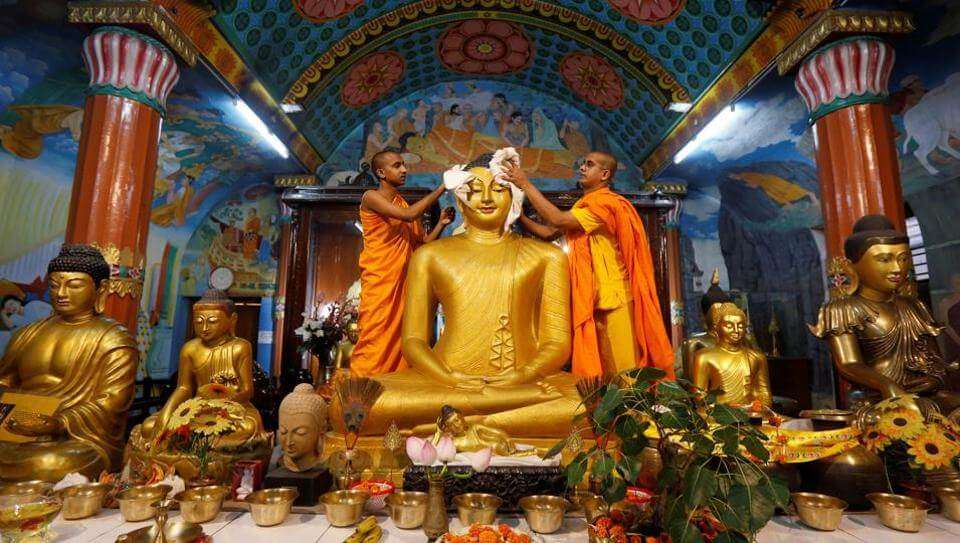
Buddha Jayanti is celebrated to mark the birthday of the Lord Buddha which dates back in about 543 BC. It falls on the full moon night of either May or June. The peace lover and Buddhist communities like to make their pilgrimage at Buddha’s birth place Lumbini of Nepal in this auspicious day.
- Gai Jatra
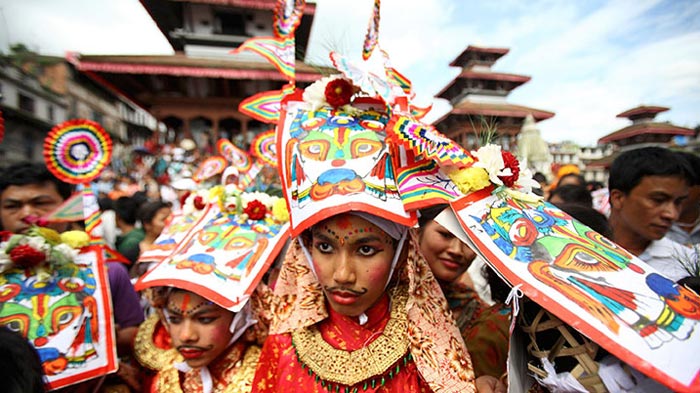
Gai Jatra is one of the most popular festivals generally celebrated in between August-September. Even though Gai Jatra has presence throughout the country, it has most strongholds in the Newari community of Kathmandu valley. This festival has its roots in the belief that the god of death, Yamaraj, must be feared and hence worshiped.
- Janai Purnima

Janai Purnima keeps the sacred meaning in Hindu community of Nepal. On this same day Rakshya Bandhan is also celebrated where every Hindu ties a sacred thread. Janai Purnima maintains the holy significance where as Rakshya Bandhan makes stronger the love and respect in between and among sisters and brothers.
- Teej
Teej is a celebration of fasting in which women pray for marital bliss, wellbeing of their spouse and children and purification of their own body and soul. It takes place on August and September. In the present context, the festival has connotation with rights of women.
- Shree Krishna Janmastami
Shree Krishna Janmastami marks the celebration of the birth of Lord Sri Krishna. Lord Krishnais regarded as the 8th avatar or ‘incarnation’ of Lord Vishnu. It falls on August and September. This festival is hugely celebrated throughout the country.
- Fagun Purnima

Fagun Purnima, allegedly named after the mythical demoness Holika, is a day when the feast of colors is celebrated. The ancient Holi festival falls on late February or on early March. It has growing popularity among Nepalese even today and it is amazingly celebrated throughout the nation.
- Maghe Sankranti
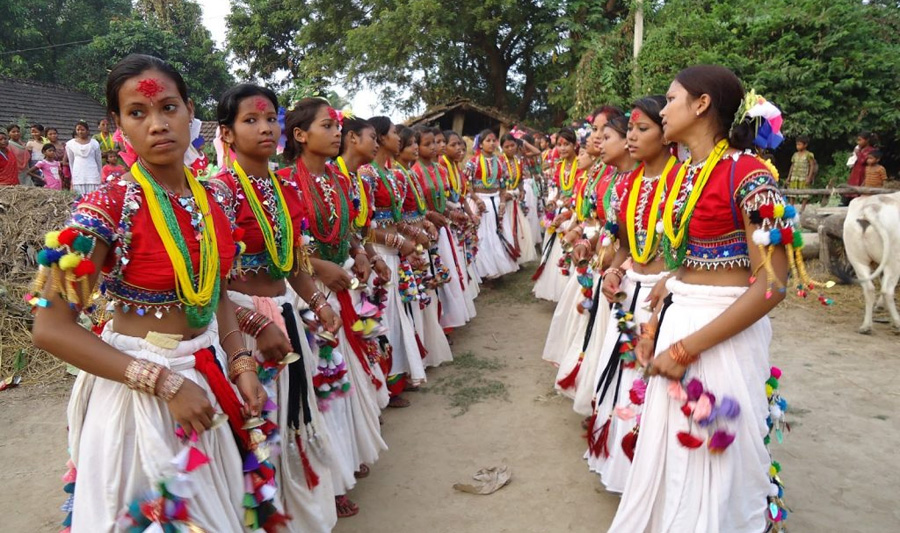
Maghe Sankranti is the harbinger of the holy month usually in the mid of January. The festival hopes to bring end of cold season and expect to coming of warmer weather and better days of health and fortune.
- Indrajatra

Indrajatra falls in August and September. Both Hindus and Buddhists unite to celebrate the festival with great enthusiasm. Indrajatra has historic significance in Nepal as well.
- Mahashivaratri

Mahashivaratri is the celebration dedicated to the Lord Shiva which falls in February and March. It is the celebration of birthday of supreme god of Hindu mythological figure. Thousands and thousands of visitors make their pilgrimage visit in Kathmandu on this day.
Apart from these festivals, Nepal celebrates more and more other regional, communal and seasonal festivals. Visit to Nepal with Himalayan Glacier, no matter which time of the year, promises a rewarding festive experience.
FOOD OF NEPAL
- Dal Bhat- The Famous Staple Food of Nepal

The staple food of each Nepali household, Dal Bhat is mainly rice served along with lentil soup and vegetable curry or chicken (or meat). This meal is the most beloved one amongst Nepali people as it’s wholesome and provides with the needed nutrition.
- Sel Roti
A fusion of doughnut and bagel, Sel Roti is one of the most sought after snack in Nepal during festivals like Tihar and Dashain. It is a circular rice flour bread which is deeply fried to make it crunchy on the outside and soft on the inside. It is crispy and sweet and tastes best with yoghurt or veggies. They’re commonly found at road-side snack stalls and made in Nepali homes during celebrations.
- Momos
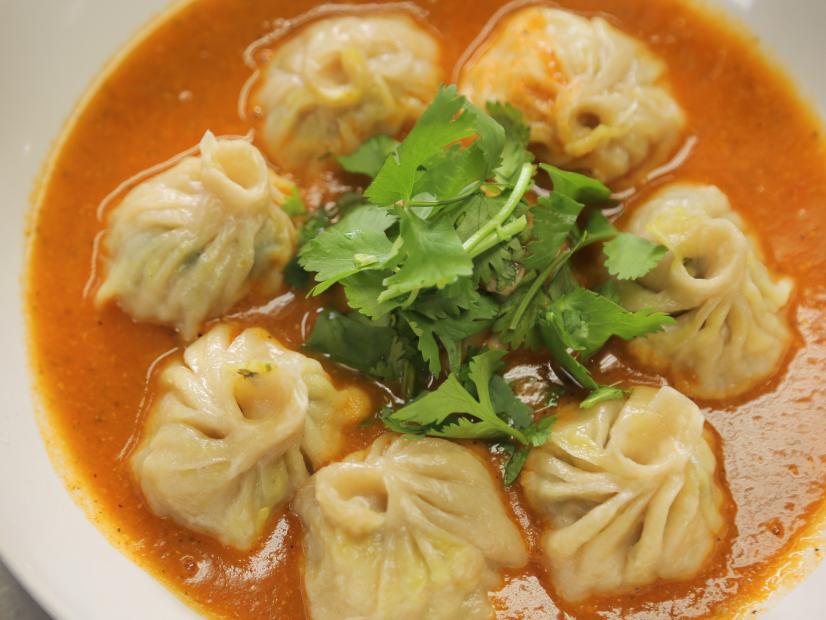
The next very popular dish is Momos. They are a favourite among Nepalis and also for tourists. Momos are small envelopes of white flour stuffed with veggies or minced lamb or chicken and are steamed, deep fried or added to a spicy soup. They are served with different kinds of sauces and mayonnaise which makes the combination a delicious snack. This food in Nepal has taken India by storm and is a popular street food across many countries as well.
- Wo or Bara
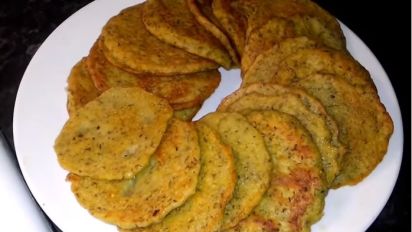
Wo is a kind of pancakes made by the Newari people of Nepal. The Newaris are an indigenous group of locals in the Kathmandu valley. Wo is made with ground lentil (green or black) batter during the ‘Sithi Nakha’, a Newari festival. These Dal patties are light and perfect for snacks. For non-vegetarians, Bara can also be added with minced chicken and battered egg.
- Yomari
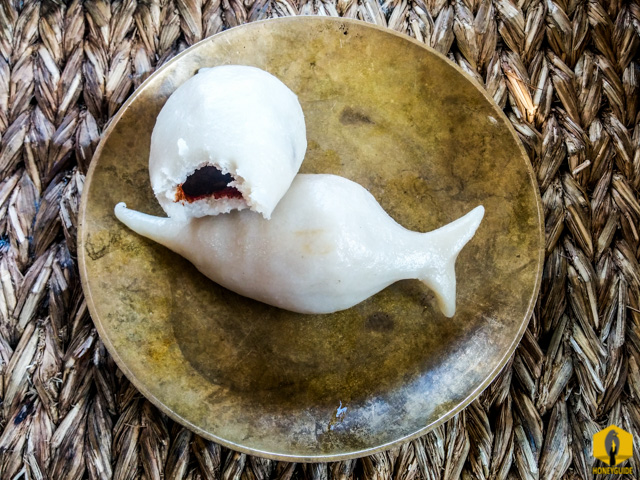
Yomari is such a special food that it has its own festival, usually celebrated in December, called Yomari Punhi. The Newari festival marks the end of the rice harvest and sweet yomari are made and eaten on this day. The pointed, fish-shaped dumplings are made from rice flour and stuffed either with a sweet molasses mixture or a coconut one. This dish is very famous is Kathmandu and you might also find its spicy version made with lentil.
- Juju Dhau

Juju dhau, or ‘king curd’, is a thick, creamy, sweetened yogurt served in clay pots in the city of Bhaktapur. It’s made with buffalo milk, so it’s much richer than regular cow’s milk yogurt. It is normally server as dessert. It’s an important accompaniment to many Newari celebrations.
ETHNIC GROUPS OF NEPAL
The large-scale migrations of Asian groups from Tibet and Indo-Aryan people from northern India, which accompanied the early settlement of Nepal, have produced a diverse linguistic, ethnic, and religious pattern. Those with Indo-Aryan ancestry, especially the Pahāṛī (including the Chhetree, the Brahman-Hill, and others), have enjoyed great prestige in Nepal for centuries, and the ruling families have been of Indo-Aryan and Hindu background. Most of the Tibeto-Nepalese groups—the Tamang, Rai, Limbu, Bhutia (including the Sherpa), and Sunwar—live in the north and east, while the Magar and Gurung inhabit west-central Nepal. The majority of the famous Gurkha contingents in the British army have come from the Magar, Gurung, and Rai groups. A third set of ethnic groups, which includes the Newar and the Tharus, are believed to have settled Nepal before the Tibetan and Indo-Aryan migrations. The Newar, who have largely adopted Indo-Aryan and Hindu customs, retain significant influence in Nepal, especially in the Kathmandu valley.
TRADITIONAL DRESSES OF NEPAL
Traditional dresses are symbolic of the art and culture of any country. They trace the timeline of the evolution of fashion dating ages back to modern times. These dresses also many times reveal the essence of nationalism of its country. So like all other countries, there are plenty of traditional dresses in Nepal that the beautiful nation boasts of.
- Dhaka Topi

Nepalese men are known for the cute little handmade ‘topis’ that they wear. The innocent smiling faces of these Himalayan men wearing these ‘topis’ are the first thought that strikes us whenever think of them. This Topi, also known as Dhaka ko Topi, actually mean headgear and is named after the capital of Bangladesh-Dhaka, because of the import of the raw materials made from there. However, they no longer depend on imports from Dhaka.
The ‘topis’ are of great significance and has established itself as a traditional national dress in Nepal. It had become famous during the rule of King Mahendra. A Nepali national is made to wear that topi in photographs for passports. The topi is widely worn in rituals, weddings, funerals, etc. Although a lot of handlooms have been set in Nepal, they are continuously keeping up their pace to meet the rising demand for their topis. Even today International Nepali Dhoti and Topi day is celebrated all across the world by Nepali Nationals on 1st January to keep their tradition and culture intact.
- Daura Suruwal

Daura Suruwal is the national dress of Nepal. It was introduced by the then Prime Minister of Nepal of the 19th Century Jang Bahadur Rana. It is also worn vastly by men of Sikkim and Darjeeling. Daura refers to the upper shirt or Kurta and Suruwal are the trouser worn. For years, Daura Suruwal has remained the same due to its religious significance and nostalgia.
The Daura Suruwal consists of 8 strings (since 8 is considered to be a lucky number according to the Nepalese people). It refers to Astamatrika-Singini which is as follows:
- Biagini
- Kumari
- Barahi
- Brahmayani
- Indrayani
- Maheshwari
- Byasnabi
- Mahalaxmi
It also consists of a closed neck which is symbolic of the snake over Lord Shiva’s neck. This is mostly worn by the Brahmins due to its religious significance.
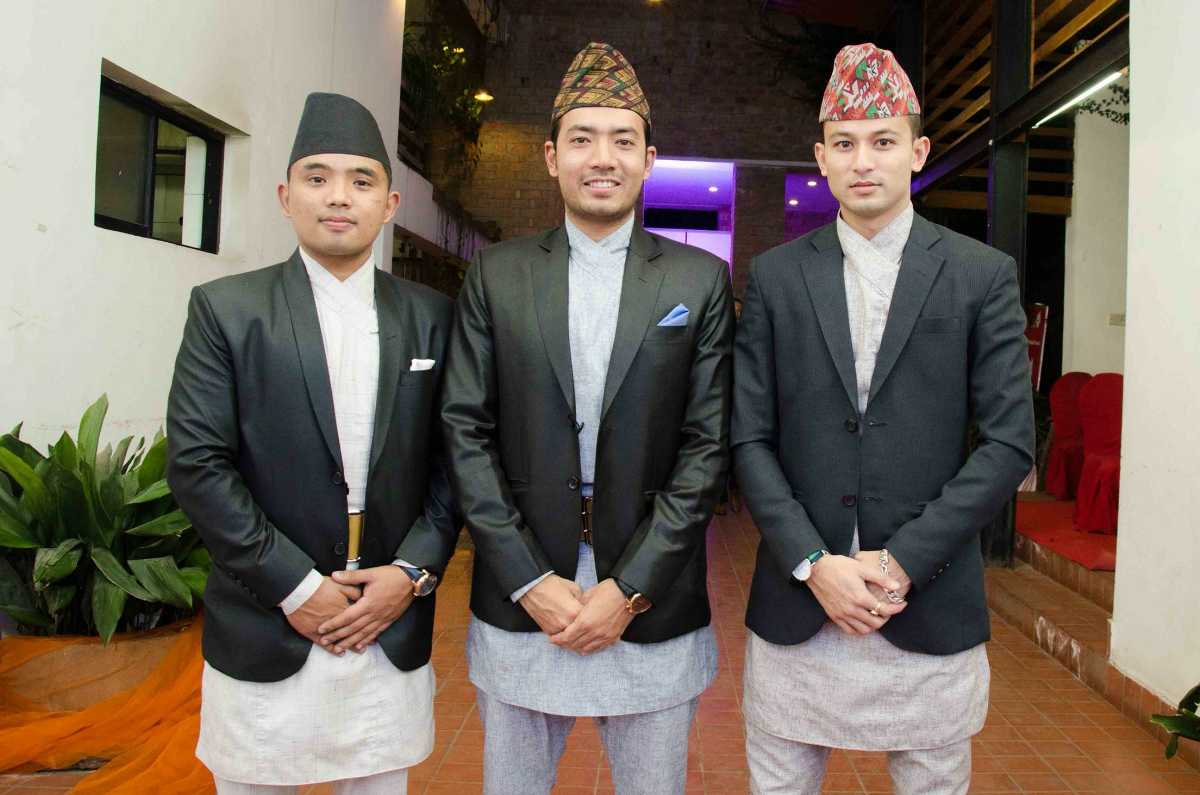
The Nepalese Prime Minister Mr Rana had worn it during his visit to England in the 19th century. This had further popularised the Daura Suruwal. History holds that Queen Elizabeth had gifted a coat to the Prime Minister which he used to wear over the Daura. This was a modification to the traditional clothing.
Once upon a time, it was mandatory for government officials to make it part of their dress code. These days, they are worn mostly by elderly people. Despite the fact that it is used less of late, it’s demand is soaring higher and higher in the international markets.
- Dhoti
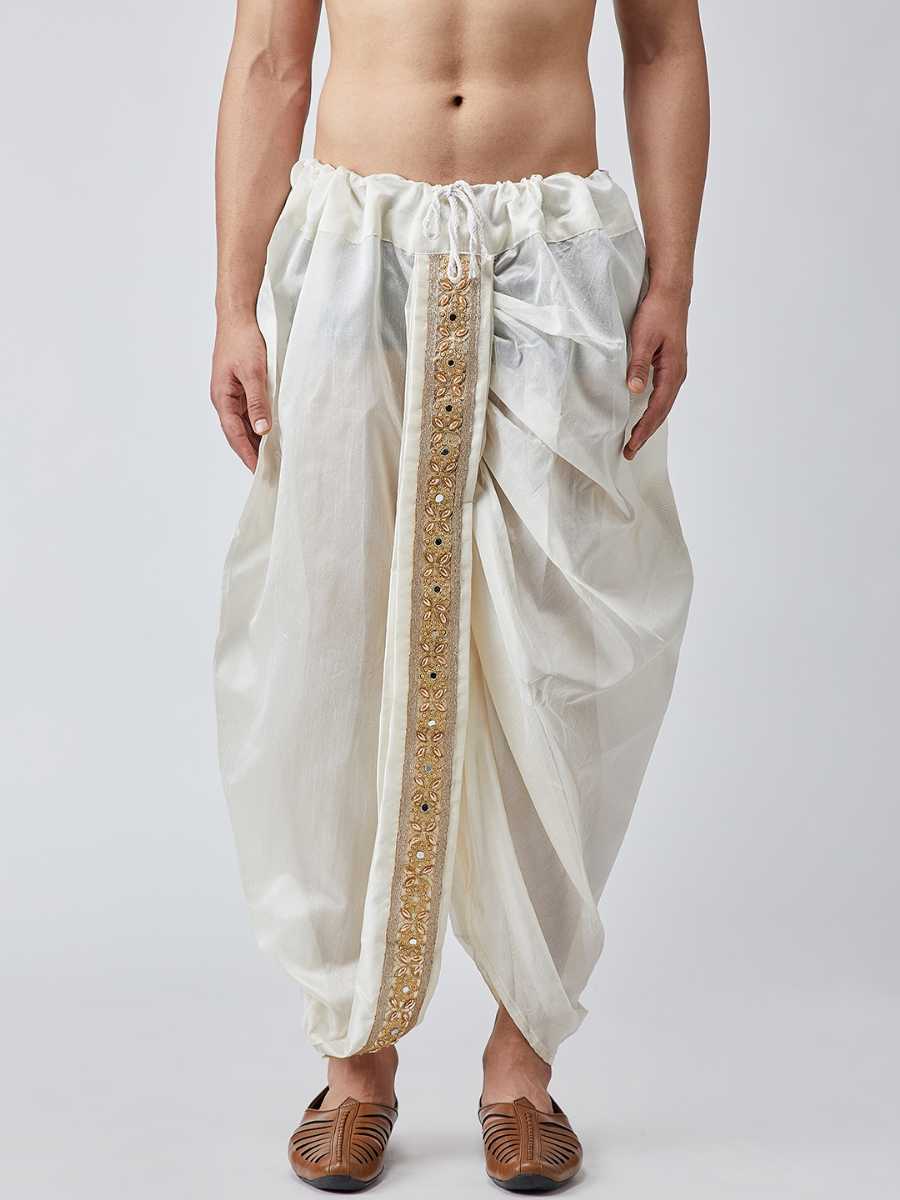
Clothes used on a day-to-day basis are as important as the festive dresses of Nepal. Dhoti is such a dress worn on a regular basis by men residing in the more humid parts of Nepal where comfortable wearing is of utmost importance. It is basically a long plain piece of fabric which is wrapped around the hips of men and tied around the waist as a substitute for trousers.
- Lungi
Lungis are similar to dhotis worn but with the purpose of comfort wear. The ends of the lungi are sewn together and they are worn by men as a long sort of skirt with one end open. Lungis are also worn exclusively by Indians. They are often sold in a variety of colours and have become a very common house-wear.
- Gunyou Cholo

This is the female equivalent dressing of the Daura Suruwal. Gunyou Cholo has a special significance apart from being a national dress of Nepal. It is used to mark the specific age of a girl (7 to 8 years). It is given to a 7 or 8-year-old girl to make a mark of her womanhood and celebrate the fact that she is slowly turning into a woman. It consists of a cholo(blouse) and a skirt accompanied by lots of jewellery. Sadly, enough, after the political uprising in 2011, both Daurya Suruwal and Gunyou Cholo have been removed as the national dress of Nepal. They continue to be worn only as ethnic wears.
- Sari
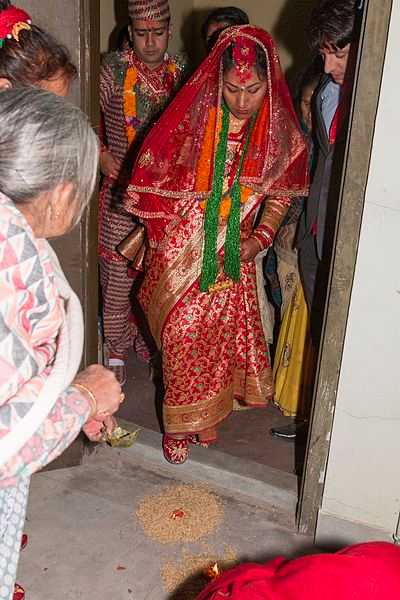 Another quite popular dress of the Nepalese women is the Sari which is worn by them for decades These saris are similar to the saris worn by the Indian women consisting of a petticoat, a blouse and sari draped around the shoulder. Sari is mostly worn with a lot of gold jewellery and ornaments. Saris are very common in festivities and are even recognized as formal wear for Nepalese women.
Another quite popular dress of the Nepalese women is the Sari which is worn by them for decades These saris are similar to the saris worn by the Indian women consisting of a petticoat, a blouse and sari draped around the shoulder. Sari is mostly worn with a lot of gold jewellery and ornaments. Saris are very common in festivities and are even recognized as formal wear for Nepalese women.
- Kurta Suruwal
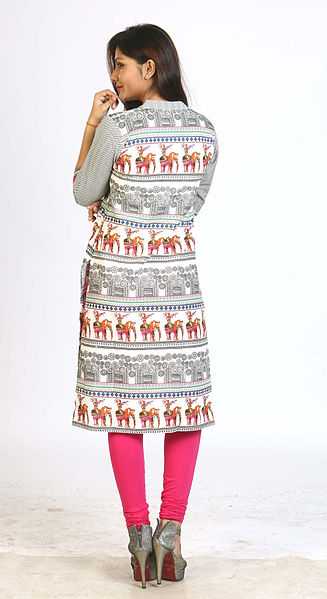
This is more of a modern dress of the Nepalese women which has developed in the recent past. It consists of baggy pants serving the purpose of trousers. The upper wear consists of a blouse, a kurta which is made up of silk or cotton, collared or collarless and a scarf as a sign of decency. They are sold in a variety of shining colour combinations all across Nepal.
· Dress Specifications According to Caste
In Nepal, people of different castes wear different sorts of jewellery and dresses of Nepal which are unique to themselves and differ from the other castes to distinguish themselves. Some of the different castes and the respective dresses worn by them are Bahun, Chhetri, Gutung, Limbu, Magar, Maithili, Newar, Raute, Rai, etc.
So once you visit this beautiful country, make it a point to shop for some of these traditional dresses of Nepal as a mark of respect to their tradition and also spreading the beautiful culture of this country all across the world.
Reference:
Nepal. (2020, July 31). Retrieved August 09, 2020, from https://en.wikipedia.org/wiki/Nepal
Zuberi, M., & Rose, L. (2020, August 07). Climate. Retrieved August 09, 2020, from https://www.britannica.com/place/Nepal/Climate
Nepal: Introduction. (n.d.). Retrieved August 09, 2020, from https://globaledge.msu.edu/countries/nepal
Choice, D. (2019, April 22). We Bet You Didn’t Know Nepal Was Home To These Bewitching UNESCO Heritage Sites! Retrieved August 09, 2020, from https://traveltriangle.com/blog/heritage-places-in-nepal/
Holidify. (2019, October 22). 11 Stunning Marvels of Architecture of Nepal and its 3 Styles. Retrieved August 09, 2020, from https://www.holidify.com/pages/architecture-of-nepal-2360.html
Languages of Nepal. (2020, July 22). Retrieved August 09, 2020, from https://en.wikipedia.org/wiki/Languages_of_Nepal
The Editors of Encyclopaedia Britannica. (2017, July 27). Nepali language. Retrieved August 09, 2020, from https://www.britannica.com/topic/Nepali-language
Holidify. (2019, October 22). Languages of Nepal – A Traveller’s Guide To Go Local & Feel Welcomed! Retrieved August 09, 2020, from https://www.holidify.com/pages/language-of-nepal-1087.html
Network, V. (n.d.). Retrieved August 09, 2020, from https://www.visitnepal.com/nepal_information/nepal_festivals.php
List of festivals in Nepal. (2020, August 08). Retrieved August 09, 2020, from https://en.wikipedia.org/wiki/List_of_festivals_in_Nepal
The 10 Major Festivals in Nepal. (2013, July 31). Retrieved August 09, 2020, from https://www.himalayanglacier.com/the-10-major-festivals-in-nepal/
Turner, E. (2018, February 03). 10 Traditional Nepali Dishes You Need to Try at Least Once. Retrieved August 09, 2020, from https://theculturetrip.com/asia/nepal/articles/10-traditional-nepali-dishes-need-try-least/
Holidify. (2019, October 10). Food in Nepal – 17 Iconic Nepalese Cuisine Items You MUST Try. Retrieved August 09, 2020, from https://www.holidify.com/pages/food-of-nepal-2118.html
Zuberi, M., & Karan, P. (2020, August 07). The people. Retrieved August 09, 2020, from https://www.britannica.com/place/Nepal/The-people
Holidify. (2019, August 21). Dresses of Nepal – 7 Beautiful Traditional Nepalese Dresses. Retrieved August 09, 2020, from https://www.holidify.com/pages/dresses-of-nepal-2127.html

